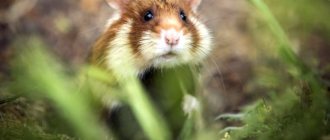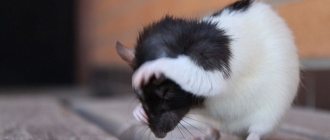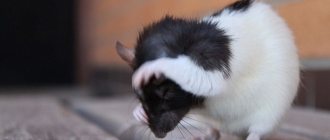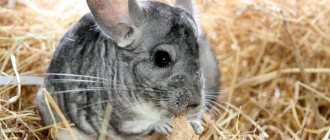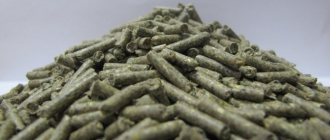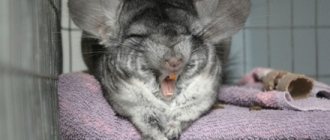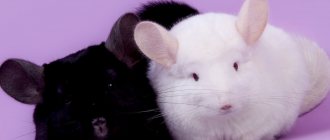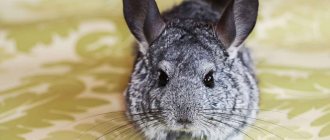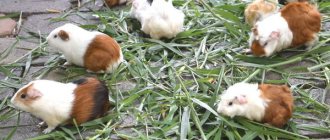- home
- Chinchilla
- Health
03/25/2019 If you periodically notice your chinchilla itching, you should not immediately sound the alarm. All animals do this sometimes, but if the animal bites itself and itches constantly, examine it. The condition of the rodent's skin determines whether it needs the help of a veterinarian, or whether a minor correction of care is sufficient.
If the chinchilla does not lose hair, it has clear skin without redness, blisters or peeling; it may itch due to the dry air in the room. In this case, limit bathing in the sand to once a week or use a humidifier. Otherwise, you need to show the animal to a specialist and carry out the treatment recommended by him.
Checking your chinchilla for fleas
Fleas prefer warm, moist places to live, ideally the fur of warm-blooded animals. This applies to the most common types of parasites - cat and dog bloodsuckers, which are no different from each other in their lifestyle. At the same time, they lay eggs on litter and other warm, hidden places. Having brought a playful, affectionate animal into your home, immediately carry out a preventative examination. Especially if he itches and bites the skin. Blood-sucking insects prefer to live on the legs and ears, since there is less fur there compared to the body. If there are no fleas, the skin is clean, smooth, without ulcers or scratches. If the above signs are found, this indicates the presence of parasites.
Important! The assumption that chinchillas do not have fleas is wrong. Their fur is thick and their love of swimming in the sand is considered a good prevention of their appearance. However, if there are insects in the apartment, chinchilla infection is inevitable!
What to do if bitten
After a light chinchilla bite, as a rule, no traces remain. But if the animal bites in a state of severe stress or aggression, a fairly deep bleeding wound may remain on the finger. In such a situation, you will need to do the following:
- put the chinchilla in a cage to avoid new bites;
- treat the wound with chlorhexidine or hydrogen peroxide;
- smear the affected area with brilliant green;
- if necessary, apply a gauze bandage.
Sometimes severe chinchilla bites can lead to suppuration. To avoid adverse consequences, you will need to treat the wound, for example, with Levomekol or Vishnevsky ointment until complete healing. If you have severe pain and inflammation, it is better to consult a doctor.
Why a chinchilla bites and what to do in this situation is a rather complex question. Only a loving owner who knows his pet best will be able to understand the true cause of aggression. The main thing is not to ignore this behavior and try to teach the fluffy to live together.
How fleas get into an apartment
If you are interested in the question of why your chinchilla itches and bites itself, check it for fleas, even if it is the only animal in the house. After all, bloodsuckers can get into a city apartment or private house in several ways:
- flea larvae or young, active insects can be carried on clothes and shoes;
- through ventilation shafts, openings;
- with sand and food, even purchased in a store;
- and the most common option is with pets who prefer warm, damp places for walking - basements, attics, sheds.
Important! If fleas are detected, you should start fighting immediately, because one mature individual lays a large number of eggs per day, which, under favorable conditions, turn into an adult insect within a few days.
Overheating (hyperthermia)
A very dangerous and life-threatening condition. Chinchillas feel comfortable at temperatures up to +18°C. The maximum permissible temperature is +25°C; higher temperatures are hazardous to health. They do not have sweat glands, so they cannot cope with excessively high temperatures.
When the temperature rises above +25°C, the chinchilla begins to feel worse and may get overheated, and at a temperature of +30°C, overheating can occur instantly and within a few hours the chinchilla will die
It is important to identify overheating in time and begin its treatment.
Symptoms that indicate overheating:
- Lethargic state, practically motionless
- Seizures
- Convulsions
- Lying on side or stretched out
- Saliva is thick
- Tongue bright red
First of all, you need to help the chinchilla with improvised means to alleviate its condition. Wet the paw pads and outside of the ears with cool water. Move the chinchilla to a cool, ventilated room without drafts. Or you can put it in a metal bathtub or on a cold tile floor. Try giving your chinchilla water.
It is very important that you do not cool it suddenly and do not put it in the refrigerator under any circumstances. Sudden cooling will lead to new diseases or death of the animal
Why is it important to take your chinchilla to the vet?
The veterinarian has invaluable experience that will help relieve the temperature faster and bring the pet back to normal. In addition, the doctor will be able to assess the condition and determine whether other organs are damaged, and then prescribe the necessary treatment.
!!!If the necessary measures are not taken in time, there will be irreversible changes.
If the overheating was severe, then you will have to leave the animal for several days in the vet. clinic until complete recovery. This pleasure is not cheap, but here it is up to you to decide whether to spend money on treatment or leave the chinchilla to chance.
How to cure overheating yourself.
ATTENTION! This information is provided by the chinchilla owner and taken from the forum. We do not guarantee a 100% cure for your chinchilla, so we recommend contacting your veterinarian.
We left this method of treatment in case the owner does not have a single veterinarian nearby.
STORY FROM THE OWNER ON TREATING OVERHEATING
It happened late at night, the chinchilla showed all the symptoms of overheating. Calls to veterinarians known to me. the clinics were unsuccessful. First of all, the chinchilla was moved to a cool room and ice was applied to the head through a towel. As a result, I managed to get through to one of the clinics, where they could only help me with a prescription. In addition, they said that it was unlikely that they could help such a fragile creature, but I decided to try.
Here's what they advised us and in the end it saved the chinchilla:
Prednisolone - 0.1 IM
Eufillin (2.4%) - 0.1 s.c.
Furosemide (Lasix) - 0.2 s.c.
Additionally, a little more Furosemide (Lasix), because the chinchilla did not pee after the first dose of medicine.
The chinchilla was still kept cool by applying cold to the head and ears. Now all that was left was to wait for everything to take effect.
Closer to 4 am, the first signs appeared that the medications were helping. My head stopped twitching nervously, I peed a couple of times and at least some movement began. An hour after the improvements, they stopped applying cold and put him in a cage separate from the other animals. Having been placed in a cage, they immediately poured water with glucose, which she happily drank. A few minutes later she went to bed.
After sleeping a little, of course, we too, injected another 0.3 Sulfocamphocaine IM. After a couple of hours, she already started eating hay. That same evening, the animal became very active and showed no signs of ill health. Just in case, we transplanted her into a common cage only every other day, constantly watching and feeding her plenty of water.
The chinchilla survived because help was immediate. We didn’t bring her to the point where they were already starting to fall, but decided to start treatment right away.
Now it’s worth telling why this happened. It was hot summer weather, and naturally they sat in a cage during the day. And in the evening, when it became quite cool, according to my feelings, the chinchillas begged for a walk with their gaze. The coolness turned out to be deceptive; the chinchillas frolicked for a long time and ran around a lot. Of the 2 chinchillas, only the girl was injured, for what reason I don’t know, maybe she is weaker, but most likely it is due to the excess weight that she suffers from.
I strongly recommend that you do not walk with chinchillas in hot summer weather. Even at +22-25 degrees with intense physical activity they can get severely overheated.
How do chinchillas get fleas?
Can a chinchilla get fleas if it is always in a cage and not in contact with other animals? This question worries many owners of cute animals. In fact, bloodsuckers can settle on the thick skin of the animal:
Important! Dogs and cats are the main sources of the spread of blood-sucking insects, especially if they are outdoors. Flea collars are not a 100% guarantee of sterility!
Causes of bites
Chinchillas are quite peaceful animals. Under normal circumstances and in the absence of irritating factors, they will not bite. Therefore, if such a nuisance did occur, most likely the animal had a serious reason for aggression.
Curiosity
Chinchillas are very curious by nature. They explore the world around them, testing everything to their teeth. If you let the animal out of the cage, it will definitely start gnawing wallpaper, baseboards, furniture and in general everything that comes in its way. And even the owner’s hand - this is how the animal shows its curiosity. At the same time, the pet does not bite in the literal sense of the word, but simply bites a little on the fingers, clothes and face of a person.
Stress
Chinchillas are naturally very shy. Therefore, even the sound of rain outside the window can throw them out of balance. During nervous overstrain, the animal may well bite the owner. The main stress factors for fluffies are:
- presence of strangers in the house;
- constant squeezing, obsessive attention, attempts to pick up or play with an animal against its will;
- loud or sudden sounds;
- the presence of other pets (for example, cats) in the room with the cage;
- trying to wake up a fluffy when he wants to sleep.
It is worth noting that when a chinchilla is very frightened, it can not only bite, but also scream loudly. And also - release a powerful stream of urine at the enemy.
Disease
Any sick animal does not like excessive attention from household members and prefers to spend time in solitude. In addition, when picked up, a sick chinchilla may experience pain. Therefore, it is not surprising that in such a situation the pet can bite the owner. The following signs may indicate health problems for your animal:
- decreased physical activity;
- loss of appetite;
- disheveled and dull fur;
- rapid breathing;
- runny nose and eyes;
- cough, sneezing;
- diarrhea or constipation.
If at least one of the listed signs appears, you need to show your chinchilla to a veterinarian. After recovery, the pet’s mood will normalize, and bites will become a thing of the past.
Harmfulness
Each animal has its own unique character. And chinchillas are no exception. Even with a trusting relationship with the owner and good living conditions, a fluffy dog can bite simply out of harm. As if flirting a little with the household. There's nothing you can do here; you'll have to put up with the antics of the wayward animal. Fortunately, such innocent bites are completely painless.
New neighbor
In general, group keeping of chinchillas is a normal practice. But only when the pets moved into the cage together. If a new neighbor is added to an established team or even to a lonely animal, conflict situations may arise.
Moreover, not only the newcomer, but also the owner risks being bitten. In this way, chinchillas express their protest and demand that the uninvited guest be removed from the cage.
Mating games
In everyday life, chinchillas behave quite calmly. The same cannot be said about puberty and mating games. During sexual hunting, the female chinchilla is aimed at communicating with the male. Therefore, the owner’s attention can irritate her.
Boys, in turn, also do not like it when, in the midst of courtship, they are suddenly picked up and carried away from the female. Therefore, during mating games, it is better to give chinchillas more freedom. When the hunting period passes, the pets will become less aggressive.
A pregnant female or one who has just given birth may also show strong dissatisfaction when trying to pick her or her babies up. It is generally better not to touch newborn puppies for 10-14 days.
Revenge
Chinchillas have an excellent memory, especially in relation to those who have offended them in some way. Therefore, in retaliation, the pet may well bite the owner or any other offender on the hand. Moreover, some furry owners do not always understand that they did something wrong. For example, a chinchilla may become angry in the following situations:
- the pet spent several days alone;
- the owner pays more attention to another pet;
- during necessary medical procedures - treating wounds, instilling drops in the pet’s eyes or nose;
Sometimes a chinchilla can bite its owner as a result of a banal accident. For example, a fairly common situation is when a fluffy dog accidentally bites a person’s finger while eating a treat from his hand.
Symptoms of fleas in chinchillas
How to determine if a chinchilla is infected with fleas? Here are the main signs:
Upon careful examination of the skin, you can see small, black dots - this is flea droppings. Serious consequences of infection can be dermatitis, anemia and the formation of worms. With dermatitis, severe hair loss occurs with the appearance of unsightly, open areas on the skin. Anemia manifests itself in pallor of the gums, nose and other mucous membranes, and weakness of the animal. Such consequences are caused by a large accumulation of fleas sucking blood.
Important! Fleas not only feed on the blood of animals, which negatively affects their well-being, but they are also carriers of helminths and other serious diseases!
On what day does the coronavirus disease peak?
The peak of the disease occurs on days 3-4, when the number of viruses in the body reaches its maximum. Therefore, at this moment the patient especially needs competent treatment. If the disease is not stopped in the first 4 days, its consequences can be fatal, and complications can be detrimental to health.
“Unfortunately, now this stage is being missed or they are starting to “kill” the patient with antibiotics literally from the first days,” comments Olga Shuppo. “Although in the first four days the infection is viral, and the antibiotic has no effect on the viruses. Antibiotics suppress normal microbiota in the intestines and disrupt the body's natural immune defense. A so-called inflammatory “cytokine storm” occurs when the immune system can no longer balance immune reactions and the correct, adequate immune response.”
Antibiotics disrupt the immune response in the first 4 days of illness (Photo: pixabay.com)
Treating a rodent for fleas
Only large-scale disinfection measures will allow you to get rid of fleas not only on the animal’s skin, but throughout the entire apartment. Immediately after detection, it is necessary to remove all inhabitants from the house and carry out disinfection with special preparations - spray or aerosol. You need to carefully treat the areas behind the baseboards, floor cracks, carpets, and upholstered furniture. After this, the apartment is thoroughly cleaned with washing and using a vacuum cleaner. All pets are also treated with insecticides and wearing flea collars.
Chinchillas have fleas, what not to do?
- Use anti-parasitic shampoos designed for larger pets.
- Bathing an animal, for which getting its fur wet can result not only in serious stress, but also a cold.
- Use chemicals such as Bars or Stronghold, which can cause poisoning.
Important! 1-2 treatments of the apartment will be enough for the insects to disappear!
Flea remedies
When using antiparasitic products intended for cats and dogs, it is worth keeping in mind that the chinchilla is much smaller in size than other pets. This means that the dose of the chemical must be reduced. Special sprays and drops can cause significant harm to the animal. Therefore, the best option would be a special collar that is used for cats and dogs. The product is less toxic compared to chemicals and safe for health.
Cell processing
Can a chinchilla have fleas after treating an apartment? Certainly! If you do not disinfect the cage in which the parasites lay their eggs. Therefore you need:
Preventive measures to avoid the appearance of parasites
If you have other pets, be sure to treat them with drops or sprays. If there is an increased threat of infection, you can update your protection a week ahead of schedule to prevent infection. It is advisable not to bring old furniture and clothes into the house. Once every 1-2 months you need to carry out general cleaning.
You can use repellents to reduce the risk of infestation in your home. Fleas do not like the aroma of citrus essential oils and garlic. If there are no essential oils, you can spread the peel of an orange or lemon into hard-to-reach places, but the effect will be weaker.
Essential oils and citrus fruits will help you fight parasites.
Prevention of fleas in chinchillas
We found out why the chinchilla itches and successfully dealt with the problem. To prevent it from occurring again, the following preventive measures must be taken:
Important! It is imperative to regularly carry out preventive disinfection of the premises! If the collar is removed too early, the rodent can become infected again with bloodsuckers from larvae left on the floor in the house, which develop into adults within a week.
Neurological diseases
If chinchillas are kept freely, lead poisoning is possible because they can find and chew on objects coated with lead paint. Clinical signs include seizures and blindness. A blood lead level of 25 mcg/ml or higher is an indicator of lead poisoning. In chinchillas with signs of lead poisoning, red blood cells with a nucleus and basophilic granularity of red blood cells are not found. For treatment, calcium EDTA is prescribed at a dose of 30 mg/kg subcutaneously every 12 hours.
A case of spinal nematode infection due to Baylisascaris procyonis infection was noted. Chinchillas became infected by eating hay and food contaminated with raccoon feces. Clinical symptoms of the disease were torticollis, ataxia and paralysis. This is an incurable disease that is zoonotic and is transmitted through the consumption of contaminated feed.
Chinchillas are very susceptible to Listeria monocytogenes infection. Outbreaks of this disease on fur farms are caused by contamination of feed and unsatisfactory sanitary conditions, but this disease has not been observed in indoor chinchillas. Clinical symptoms include ataxia, circling, seizures, and death. The infection is treated with chloramphenicol and oxytetracycline, but they are usually ineffective once clinical symptoms appear.
Reviews
- Chinchillas have fleas, especially if there are other animals at home - dogs and cats. My Polya itched and behaved restlessly until I completely disinfected the apartment, cage and all pets. The chinchilla has become playful and cheerful again!
- I used to think that chinchillas don’t have fleas - their fur is too thick. But, recently a veterinarian pointed out their presence and suggested how to deal with it. I was very surprised, because there are no more animals in my house. But often children take her to the dacha, where most likely she became infected with parasites.
- When we got a chinchilla, we didn’t even think about the possibility of flea infestation. We didn’t have them in our house, nor did our cat, which I regularly treat against parasites. But, after a while, I discovered that the new member of the household was itching a lot and biting himself. I looked, parting the pile of thick fur - and there were a great many of them! Conducted a complete disinfection of the house, furniture, cats and rodents. A single treatment was enough to get rid of insects
Watch a video about treating rodents for fleas:
Source
Venipuncture
In chinchillas, the lateral saphenous veins of the thoracic and pelvic limbs are recommended for venipuncture. An ear vein is recommended to take a small amount of blood. You can also take blood after trimming the claw, since chinchillas have vestigial claws and there will be no traumatic pain or severe bleeding. Table 3 shows the hematological and biochemical indicators of normal chinchillas.
| Table 3. Hematological and biochemical parameters of chinchilla serum normal | |
| Hematocrit (%) | 27-54 |
| Red blood cells (106/ml) | 5,6-8,4 |
| Hemoglobin (g%) | 11,8-14,6 |
| Leukocytes (103/ml) Neutrophils (%) Lymphocytes (%) Monocytes (%) Eosinophils (%) Basophils (%) | 5,4-15,6 39-54 45-60 0-5 0-5 0-1 |
| Alanine aminotransferase (IU/l) | 10-35 |
| Alkaline phosphatase (IU/l) | 6-72 |
| Aspartate aminotransferase (IU/l) | 96 |
| Total bilirubin (mg/dl) | 0,6-1,28 |
| Calcium (mg/dp) | 5,6-12,1 |
| Chloride (mEq/L) | 108-129 |
| Cholesterol (mg/dl) | 50-302 |
| Creatinine(mg/dl) | 0,4-1,3 |
| Glucose (mg/dl) | 109-193 |
| Phosphorus (mg/dl) | 4-8 |
| Potassium (mEq/L) | 3,3-5,7 |
| Total protein (g/dl) Albumin (g/dl) Globulin (g/dl) | 3,8-5,6 2,3-4,1 0,9-2,2 |
| Sodium (mEq/L) | 142-166 |
| Urea nitrogen (mg/dp) | 17-45 |
| Taken from Carpenter JW, MashimaTU, RupiperDJ: Exotic Animal Formulary. Manhattan, KS: Greystone Publications, 1996. |
Do I need to rinse my eyes?
Of course it is necessary. Another question - with what?
Quite often, owners use decoctions of medicinal herbs to wash their pets - strong tea, chamomile or calendula decoction. Veterinarians do not advise doing this for a number of reasons: they dry out the mucous membrane, it is impossible to maintain the normal concentration of the solution, such decoctions quickly become unusable, becoming a source of secondary bacterial infection.
To wash the eyes of a chinchilla, it is advisable to use special lotions - Lakrimin, Lakrikan, Ofto-lavas.
In the absence of special means, you can wash your chinchilla’s eyes with simple freshly boiled and cooled water or sterile saline solution.
